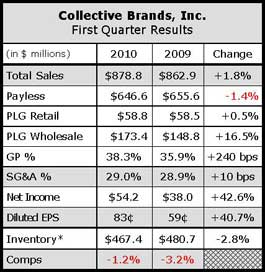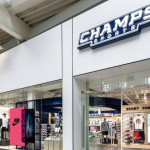Collective Brands, Inc. reported that first quarter earnings jumped 43% aided by solid double-digit gains from Saucony, Sperry Top-Sider and Keds, as well as a 240 basis point improvement in gross margins. Unfortunately, the one laggard was its biggest segment, Payless Domestic, which offset much of the gains seen elsewhere and led PSS to a more meager 1.8% overall revenue gain for the quarter.
At Payless Domestic, sales dropped 24.2% to $546.6 million due to store closings and a 4.2% decline in comps. Healthy increases in accessories, sandals and fitness categories, as well as higher conversion rates and units per transaction, were not able to offset a high-single digit percentage decline in customer traffic.

“The mass-tier consumer, more significantly affected by unemployment, has been slow to return to the footwear marketplace,” said company EVP and CAO Doug Treff. “Payless has felt this impact, particularly in the Southwest, along the Mexican border and in the California markets.”
Matt Rubel, chairman, president and CEO, added that a lack of clearance priced footwear early in the quarter, due to a low inventory position at year end also impacted sales. Said Rubel, “Sales accelerated with a solid Easter and post-Easter period, driven largely by sandals until dropping off near the end of the quarter due to colder than usual weather.”
On the bright side, better inventory management supported margin gains and helped operating profits increase 7.1% to $49.3 million.
Children's footwear outperformed adult footwear, led by sandals and dance shoes.
Rubel said Champion toning offerings “sold well on limited stock” at Payless in Q1. With higher inventory levels, Champion toning styles priced from $24.99 to $39.99 – will be supported by a comprehensive marketing campaign, including TV, online, and print media starting in early June. Added Rubel, “We're trying to kind of get that middle income customer in who doesn't want to have to spend $80, $100 on the product. We should be able to create some noise with that.”
In the Payless International segment, sales climbed 17.9% to $100 million for the quarter.
Comps increased 14%, and advanced over 5% on a constant-currency basis. Sales growth was broad-based with every Latin American country and Canada enjoying comp increases. Operating earnings nearly quadrupled to $7.1 million from $1.8 million in the prior-year quarter.
PLG Wholesale saw sales increase 16.5% to $173.4 million, with double-digit percentage gains at Saucony, Sperry and Keds both domestically and internationally.
Premium channels and e-commerce were among the fastest growing channels of the wholesale segment. Operating profits vaulted 62.9% to $23.3 million with strong profit growth at Saucony, Sperry and Keds. Backlog was up nearly 50% at the end of first quarter.
Saucony saw broad-based strength with sales growth across all geographies and selling channels, most notably domestic sporting goods. Re-designs of the Guide and Ride models led run specialty, while the Cohesion and Ignition models were top at sporting goods channels. Rubel also said Saucony is advancing its strategy to grow among consumers 18 to 24, and reaching more male consumers. Saucony is also amplifying its presence in track and field, marked by the signing of two Olympian sprinters, Lauren Williams and Dee Dee Trotter.
Looking ahead, Saucony's growth “is sustainable with a healthy pipeline of great product.” Rubel noted that the Kinvara, Saucony's minimalist offering, as well as the Triumph 7 have received awards in the press. In addition, Saucony apparel is expected to see accelerating trends, helped by the July launch of AMP PRO 2 compression apparel.
Sperry benefited from a more profitable channel mix, with the premium digital channel particularly strong. Non-boat and women's product, such as dress casual product, also performed well.
Keds “has turned the corner in its operating performance” and increased global sales by double-digit percentage, driven primarily by the growth of the Champion silhouette in premium accounts,” according to Rubel. Keds increased its first quality sales, had fewer closeouts with the brand and continued to be elevated through designer and retail collaborations. An example given was Alice & Olivia program at Neiman Marcus. In connection with the Whitney Museum, a Keds Whitney collection is being launched in July as an exclusive at Bloomingdale's. Said Rubel, “Keds is well positioned for growth in 2010 with new accounts, as well as door for door growth.”
The Grasshopper brand, part of the Keds group, is being repositioned to address comfort, fitness and toning.
Collective Brands to Roll Out Toning across Multiple Brands…
Drafting off the Champion success, Collective will pursue what Rubel sees as a $1.5 billion to $2 million fitness/toning opportunity through Grasshopper, Keds and Saucony in different channels. With a focus on technology, Saucony toning product will be priced in the $85 to $100 range.
Internationally, sales of PLG Wholesale brands increased by double-digit percentages, driven primarily by stronger results in Europe. The continued success of Saucony, its biggest international brand, has helped other brands enter Europe. Sperry saw the strongest international growth.
Stride Rite Wholesale had slightly lower sales for the quarter, but TV and direct marketing support around new Stride Rite concepts such as Slingshot and Glitzy Keds are expected to drive growth in the back half. New licenses such as Star Wars, Clone Wars, Slimers and programs like Princess from Disney are also being planned.
PLG Retail sales inched ahead 0.5% to $58.8 million as new stores, higher e-commerce sales, and in-store shops at Macy's offset declines in the remaining Stride Rite children's and outlet stores. PLG Retail's operating earnings declined 13.6% to $1.9 million, partly due to costs incurred from five new Sperry stores.
Overall company gross margin increased 240 basis points to 38.3% as a result of lower markdowns due to its clean inventory position; a high single digit percentage reduction in product costs due to lower commodity prices; leveraging the size and scale of its global supply chain; lower freight and distribution costs; and savings from the closure of the Topeka distribution center last year.
Inventories were down 3% at the quarter's end due to lower product costs, fewer footwear units and a reduction in aged inventory at Payless.













